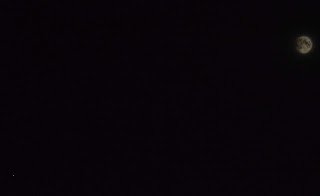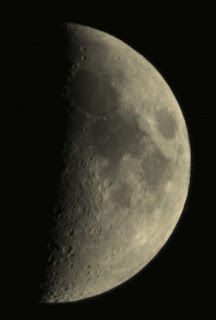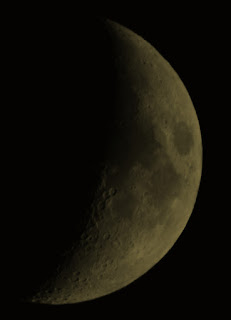June 30th 2205 GMT
I did some shots of Jupiter's moons with my DSLR at 300mm focal length, ISO 6400 and 1 second exposure.
June 30th 2320 GMT
I did not have work the next day, so I decided to take a look at Jupiter and Saturn. I had not seen either for a while.
I started with Jupiter at 77x magnification. The northern cloud belt was very clear but the southern one went in and out of view, due to atmospheric turbulence on our own planet. I increased the magnification to 231x, using a 3x Barlow lens but the planet and its moons were dancing in the eyepiece. I reverted to 77x magnification and concentrated for a while. The north cloud belt appeared to have a jagged edge but the south one was fainter and straight. I could see three moons but a fourth appeared from behind the planet's disc.
I took some afocal shots with my DSLR, almost as an afterthought, as my prime objective was visual.
I kept the same magnification level. as I moved to Saturn. It was nice to see the rings and I could make out a ring on the cloud tops but was not sure whether it was a cloud belt or the shadow of the rings. The Cassini Division was far from clear and there was no sign of Titan. I took some afocal shots again.
I returned to Jupiter and took some frames using my Mak and DSLR with 1.54m focal length, ISO 6400 and 0.4 seconds exposure. That was the last action of the session, as cloud moved in.
I combined the images from Jupiter and its moons.
June 28th 2200 GMT
I tried to snap Jupiter's moons but was struggling for stability and focus.
June 27th 2125 GMT
June 27th 1420 GMT
The Sun was quiet in hydrogen alpha light but I took some shots anyway.Very unusually, especially for June, it was my first attempt of the month!
June 22nd 0455 GMT
The Sun was up but I took some shots of the waning gibbous moon at ISO 6400, 300mm focal length and 1/4000 second exposure.
June 21st 2230 GMT
As I had work the next day, it was a quick session before bedtime. I snapped Jupiter at 300mm focal length, ISO 6400 and 2 seconds exposure in an attempt to capture its moons. I tried some short exposure shots of Jupiter and Saturn with some more 2 second exposure overhead.
Jupiter showed two moons and plenty of background stars.
I caught a hint of the cloud belts and a moon shadow.
Nothing came from the Saturn nor overhead shots.
June 15th 2230 GMT
The sky was clear-ish and I could see the Moon and Jupiter. I took 3 sets of frames:
The Moon at 300mm focal length, ISO 100 and 1/1000 second exposure. I stacked the best 3 frames.
The Moon with Jupiter at 70mm focal length, ISO 6400 and various exposures.I combined the result with the above image to get this.
June 14th 2220 GMT
I was late in from work, so did just a quick few frames of the Moon at 300mm focal length, ISO 100 and 1/1000 second exposure.
June 9th 2110 GMT
I repeated the Moon shot with the same settings from the night before.
June 9th 0000 GMT
The sky started cloudy but there were no clear patches left when I finished the session. I took a few constellation shots, more in hope than expectancy.
A dirty lens meant that I could not use all of the Cygnus/Lyra frame.
The Bootes shot was ruined by camera shake.
I had one nice frame of Ursa Minor and it was not too bad.
June 8th 2200 GMT
The Sun had set but there was still a lot of daylight lingering. I had another go at the Moon with 300mm focal length, ISO 100 and 1/250 second exposure.
June 8th 1820 GMT
I took some shots of the Moon with my DSLR at 300mm focal length, ISO 400 and 1/800 second exposure.




















No comments:
Post a Comment